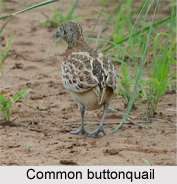 Common Buttonquail or Kurrichane Buttonquail is a buttonquail, one of a small family of Indian Bird which resemble with the true quails. Common Buttonquail species is resident from southern Spain and Africa through India and tropical Asian countries like India and Bangladesh to Indonesia.
Common Buttonquail or Kurrichane Buttonquail is a buttonquail, one of a small family of Indian Bird which resemble with the true quails. Common Buttonquail species is resident from southern Spain and Africa through India and tropical Asian countries like India and Bangladesh to Indonesia.
Structure of Common Buttonquail
Common Buttonquail is notoriously difficult to see. It is a small, 15 centimetres long drab running bird, which avoids flying.
Residence of Common Buttonquail
Common Buttonquail inhabits warm grasslands or scrub jungle and feeds on insects and seeds. This species avoids thick forest and hilly country, and lives by preference in cornfields and stretches of grassy plain though it may also be found in any type of low herbage and open scrub jungle. It skulks and is flushed with difficulty; rising often close by one`s feet. When flushed it flies low over the ground and soon settles again, after which it is very difficult to put up a second time.
Behaviour of Common Buttonquail
The female Common buttonquail initiates courtship and builds the ground nest. The male Common buttonquail incubates the normally four speckled greyish eggs, and tends the young, which can run as soon as they are hatched.
Nestling Season of Common Buttonquail
The nesting season of Common buttonquail is June to September. The nest is a slight pad of grass placed in a natural hollow in the ground where it is usually tucked away amongst the stems of a tuft of grass. Very occasionally the grass is bent over it in a sort of canopy.
Sounds of Common Buttonquail
The female Common Buttonquail calls with a deep "hoom-hoom-hoom" and the male replies in "kek-kek-kek".
Population of Common Buttonquail
The population size of Common Buttonquail has not been quantified. But it is not believed to approach the thresholds for vulnerable under the population size criterion. The global population size of Common buttonquail has not been quantified, but the species is reported to be scarce to locally abundant. The national population of Common buttonquail sizes have been estimated at 100 breeding pairs in China and 100 breeding pairs in Taiwan, in the extreme Eastern countries of the world.











